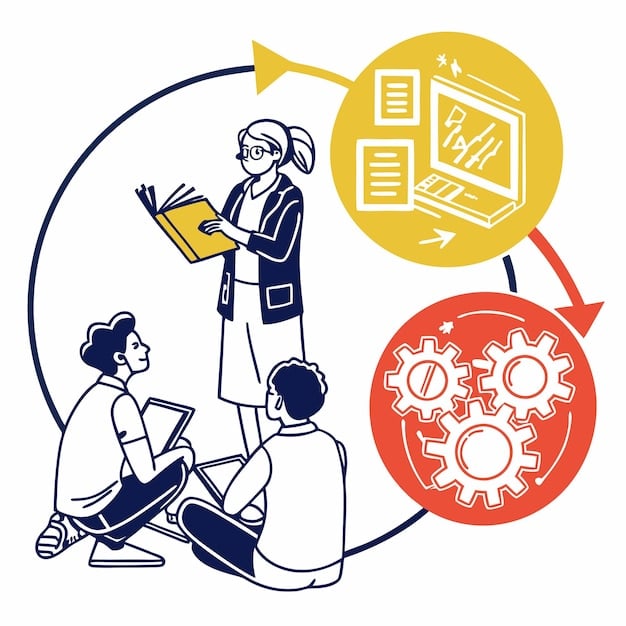EdTech Innovations: Adaptive Platforms Transforming US Online Learning

Leveraging cutting-edge adaptive platforms, EdTech innovations are revolutionizing online learning for US students by personalizing educational experiences, enhancing engagement, and improving academic outcomes through tailored content and real-time feedback mechanisms.
In the dynamic landscape of education, the emergence of EdTech innovations marks a pivotal shift, particularly with the rise of adaptive platforms. These pioneering solutions are not merely supplementing traditional learning but fundamentally reshaping how US students interact with educational content, offering a personalized journey previously unimaginable. This article delves into the transformative impact of these platforms, exploring their mechanisms, benefits, and the future they envision for online learning.
the evolution of online learning and the need for adaptation
Online learning has progressed significantly from its early days of static content and rudimentary virtual classrooms. While it offered accessibility, it often lacked the engagement and personalized feedback inherent in traditional settings. This gave rise to a critical need for more dynamic, responsive educational tools.
Technology started to bridge these gaps, transforming simple digital syllabi into interactive experiences. The initial shift brought forth platforms enabling video conferencing and shared documents, allowing for real-time interaction. However, these early iterations still largely maintained a one-size-fits-all approach, often failing to cater to the diverse learning styles and paces of individual students. This posed a significant challenge, as a rigid curriculum could leave some students struggling to keep up while others felt unchallenged and disengaged.
The recognition of these limitations spurred the development of more sophisticated solutions. Educators and technologists began to envision systems that could adapt to the student, rather than the student adapting to the system. This vision laid the groundwork for the adaptive learning platforms we see today, designed to respond to individual needs with precision and fluidity.
from rigid curricula to tailored pathways
The journey from generic digital courses to personalized learning environments involved significant innovation. Early online platforms, while convenient, operated on a fixed sequence of lessons and assessments, mirroring traditional classroom structures without accommodating individual differences.
These foundational systems, despite their limitations, highlighted the potential for wider educational access. However, they also underscored the necessity for more intelligent design, prompting a shift in focus from mere digitization to genuine pedagogical enhancement. The goal became to create learning experiences that were not just accessible but also effective for every learner.
- early online courses: primarily static content delivery.
- interactive platforms: introduced basic communication and resource sharing.
- adaptive learning’s genesis: recognizing the need for individualized pace and content.
the growing need for personalized education
The American education system, grappling with diverse student demographics and varying foundational knowledge levels, presented a fertile ground for adaptive learning. Traditional classrooms, even with dedicated teachers, struggled to provide truly individualized attention to every student.
This challenge became even more pronounced with the expansion of online learning, where the physical presence of an instructor to gauge comprehension and adjust teaching methods was absent. Adaptive platforms emerged as a viable solution, promising to bridge this gap by offering a scalable way to personalize education on a mass scale. They address the inherent variability in how students acquire knowledge, ensuring that content delivery and difficulty adjust to foster optimal learning.
adaptive platforms defined: what sets them apart?
Adaptive learning platforms are sophisticated educational technologies that utilize artificial intelligence and machine learning to analyze a student’s performance, strengths, and weaknesses in real-time. Based on this data, they automatically adjust the learning path, content, and pace to provide a highly personalized educational experience. Unlike static online courses, these platforms are dynamic and responsive, continually optimizing the learning journey for each individual.
These systems go beyond simple branching logic; they employ complex algorithms to predict areas where a student might struggle, offer remedial content proactively, or provide advanced challenges when a student demonstrates mastery. The core principle is self-correction and continuous optimization, making the learning process more efficient and engaging.
how ai and machine learning power personalization
The intelligence of adaptive platforms lies in their sophisticated use of AI and machine learning. These technologies enable the platforms to gather vast amounts of data on student interactions, including response times, accuracy, and engagement levels.
This data is then processed to build a comprehensive profile of each learner. AI algorithms analyze patterns in this data to identify learning gaps, preferred learning styles, and areas of deep understanding. This detailed analysis allows the platform to make informed decisions about content delivery, ensuring that each student receives material that is appropriately challenging and relevant. The machine learning component continuously refines these algorithms, improving the platform’s ability to adapt over time as it interacts with more students and gathers more data.
- real-time data analytics: monitors student performance and engagement.
- predictive modeling: identifies potential learning obstacles before they become significant.
- content recommendation engines: suggests resources tailored to individual needs.
key features of leading adaptive education solutions
Leading adaptive platforms incorporate a range of features designed to enhance the learning experience. These include dynamic content adjustment, where the difficulty or type of material changes based on student performance. They also offer intelligent tutoring systems, providing immediate, constructive feedback and hints.
Furthermore, personalized assessments are crucial. These platforms don’t just test knowledge but also diagnose misconceptions, guiding students back to foundational concepts if needed. Progress tracking and analytics dashboards empower both students and instructors, offering clear insights into performance and areas requiring focus. Some platforms even integrate gamification elements to boost engagement and motivation.
startup spotlight: pioneering adaptive learning
The EdTech landscape is brimming with innovative startups, but a select few are truly making waves in adaptive learning. These companies are not just building software; they are crafting entire learning ecosystems designed to transform educational outcomes for US students. Their approaches vary, but a common thread is the commitment to leveraging technology for deeply personalized and effective learning experiences. These startups are characterized by their agility, their focus on specific educational challenges, and their rapid deployment of cutting-edge solutions.
profiling visionary edtech startups
Several startups stand out for their innovative contributions to adaptive learning. One notable example might be “CogniLearn,” a platform focusing on K-12 math and science, which uses AI to identify precise knowledge gaps and deliver micro-lessons to address them. Another, “SkillSynapse,” targets vocational training, adapting content to employment market demands and individual skill sets. These startups share a common goal: to move beyond standardized education and embrace individualized learning journeys. Their success often lies in their sharp focus on specific educational niches, allowing them to deep-dive into the unique challenges and opportunities within those areas.
Their methodologies distinguish them. For instance, CogniLearn dynamically adjusts problem difficulty and explanation style based on a student’s real-time accuracy and confidence levels, ensuring optimal challenge without frustration. SkillSynapse, on the other hand, might integrate simulations and scenario-based learning, which adapt to a learner’s decision-making within virtual environments, honing practical skills. These diverse approaches underscore the breadth of innovation in this sector.

impact on us student learning outcomes
The impact of these innovative adaptive platforms on US students is becoming increasingly evident. Early data suggests significant improvements in academic performance, with students demonstrating better retention of material and higher test scores. Beyond mere grades, these platforms foster deeper understanding and greater confidence.
Students who traditionally struggled in conventional settings often thrive in adaptive environments, as they receive the precise support they need without feeling rushed or left behind. The personalized nature also cultivates a sense of agency and ownership over their learning, transforming passive recipients into active participants. This empowerment is crucial for long-term academic success and intrinsic motivation.
Anecdotal evidence from educators and parents further supports these quantitative findings, highlighting increased engagement and reduced anxiety around learning. The ability to revisit concepts without judgment, or accelerate through familiar topics, creates a much more positive and effective learning atmosphere.
case studies: success stories in adaptive learning implementation
Examining real-world applications of adaptive learning platforms provides concrete evidence of their efficacy. From large public school districts to specialized tutoring centers, various educational settings across the US are leveraging these technologies to achieve remarkable results. These case studies highlight not only improved academic metrics but also the broader positive impacts on student engagement and teacher workload. They offer valuable insights into the practical aspects of implementation, including curriculum integration and professional development for educators.
transforming k-12 education
In a large urban school district in Texas, implementing an adaptive math platform led to a 15% increase in math proficiency scores among middle school students within one academic year. The platform identified individual student weaknesses, providing targeted practice and explanations, which significantly reduced the typical struggle with core concepts. Teachers reported spending less time on remedial instruction for the entire class and more time offering individualized support to students who needed it most, or enriching lessons for advanced learners. This balanced approach allowed them to cater to a wider spectrum of learning needs effectively.
Similarly, an elementary school in California used an adaptive reading program that adjusted to each child’s reading level and interests. This resulted in a noticeable improvement in reading fluency and comprehension, especially among students who were previously falling behind. The students became more enthusiastic about reading, as the content was always relevant and appropriately challenging. Teachers observed a significant reduction in reading anxiety.
revitalizing higher education and professional development
Adaptive learning is also making significant inroads in higher education. A major state university introduced an adaptive chemistry course for its freshman cohort. The platform offered personalized pathways through the curriculum, allowing students to master foundational concepts at their own pace before moving to more complex topics. This approach led to a 10% decrease in D/F/withdraw rates compared to traditional lecture-based courses. Students expressed appreciation for the ability to review difficult concepts repeatedly without feeling rushed.
In the realm of professional development, a corporate training company utilized an adaptive platform for its compliance training modules. Instead of a one-size-fits-all approach, the platform assessed each employee’s existing knowledge and tailored the content to fill specific gaps. This resulted in a 25% reduction in training time while maintaining, or even increasing, compliance knowledge retention. The efficiency gained translated directly into cost savings and increased productivity, demonstrating the versatility of adaptive learning beyond traditional academic settings.
challenges and future outlook for adaptive platforms
While adaptive learning platforms show immense promise, their widespread adoption and continued evolution face several challenges. These include issues related to data privacy, equitable access to technology, and the need for ongoing teacher training. Successfully navigating these hurdles will be crucial for these platforms to fulfill their potential in revolutionizing education. However, the future outlook remains overwhelmingly positive, with ongoing advancements in AI and learning science promising even more sophisticated and impactful solutions.
addressing data privacy and equitable access
The reliance of adaptive platforms on student data raises legitimate concerns about privacy. Protecting sensitive student information from breaches and misuse is paramount. Developers must implement robust cybersecurity measures and adhere to strict data governance policies, ensuring transparency in how data is collected, stored, and utilized. Educating parents and students about these safeguards is also essential to build trust and encourage adoption.
Equitable access poses another significant challenge. The benefits of adaptive learning can only be fully realized if all students, regardless of their socioeconomic background or geographical location, have access to the necessary technology and internet connectivity. Initiatives to provide devices and broadband internet to underserved communities are vital. Without addressing the digital divide, adaptive platforms risk exacerbating existing educational inequalities rather than bridging them.
- data security protocols: paramount for protecting student information.
- transparent data usage policies: building trust with users.
- bridging the digital divide: ensuring universal access to technology.
the roadmap ahead: continuous innovation
The future of adaptive learning is characterized by continuous innovation. We can anticipate even more sophisticated AI algorithms that can understand complex learning behaviors, including emotional states and cognitive load, to further optimize the learning experience. Integration with virtual and augmented reality (VR/AR) is on the horizon, creating immersive and interactive learning environments.
Imagine students not just reading about historical events but experiencing them through VR, with the platform adapting the narrative based on their engagement and understanding. The synergy between different EdTech tools will also intensify, with adaptive platforms seamlessly integrating with communication tools, collaborative platforms, and holistic student support systems.
Furthermore, there will be an increased focus on pedagogical research to inform platform development, ensuring that technological advancements align with the best educational practices. The goal is not just to automate learning but to enrich it, fostering critical thinking, creativity, and problem-solving skills that are essential for future success.
integrating adaptive learning into existing educational frameworks
The successful integration of adaptive learning platforms into existing educational frameworks is a complex but crucial undertaking. It’s not enough to simply introduce new technology; a thoughtful strategy is required to ensure these platforms complement traditional teaching methods, enhance curriculum delivery, and empower educators. This involves careful planning, professional development, and a willingness to adapt existing structures.
synergy with traditional teaching methods
Adaptive learning platforms are most effective when viewed as powerful tools that augment, rather than replace, the role of the teacher. Instead of being solely didactic, educators can leverage these platforms to personalize instruction, allowing them to focus on facilitating deeper discussions, providing one-on-one mentorship, and addressing socio-emotional learning needs. For example, a teacher might use an adaptive platform to pre-assess student knowledge before a unit, then use class time for collaborative activities, knowing that the platform is providing individualized remedial or enrichment exercises.
This blended learning approach allows the teacher to act more as a guide and mentor, freeing them from the constant need to deliver generic content. It enables them to identify specific areas where students struggle or excel and intervene precisely, transforming the classroom into a dynamic, responsive learning environment. The platform handles the repetitive aspects of instruction, allowing teachers to focus on higher-order thinking skills and creative problem-solving.
empowering educators for the digital age
For adaptive learning to truly succeed, educators need comprehensive training and ongoing support. This includes not only technical proficiency in using the platforms but also pedagogical understanding of how to best integrate them into their teaching strategies. Professional development programs should focus on data interpretation, helping teachers understand the insights provided by adaptive platforms to inform their instructional decisions.
Furthermore, educators should be involved in the selection and customization of these tools, ensuring they meet the specific needs of their students and curricula. Empowering teachers with these capabilities transforms them into architects of personalized learning experiences, rather than simply users of technology. This investment in human capital is as critical as the technology itself, recognizing that the most advanced tools are only as effective as the skilled professionals wielding them.
Regular workshops, peer learning communities, and access to expert support can help teachers continually refine their approach. This ongoing professional growth ensures that adaptive platforms are fully utilized to their potential, creating a virtuous cycle where technology enhances teaching, and teaching maximizes the benefits of technology.
the economic and social impact of edtech innovation
The ripple effects of EdTech innovation, particularly through adaptive platforms, extend far beyond the classroom, touching upon significant economic and social dimensions. These technologies are not only shaping the future of education but also influencing workforce development, economic competitiveness, and social equity. Understanding these broader impacts is essential for appreciating the full scope of their transformative potential.
driving workforce readiness and economic growth
Adaptive learning platforms play a crucial role in preparing a more skilled and adaptable workforce. By personalizing education and vocational training, they ensure that students and professionals acquire the specific competencies demanded by evolving industries. This leads to a more responsive and competitive workforce, capable of filling critical skill gaps and driving economic innovation. For instance, platforms that adapt to industry-specific requirements can quickly upskill workers in emerging fields like AI, cybersecurity, or green energy.
The efficiency and effectiveness of adaptive training also reduce the time and cost associated with skill development. This enables businesses to respond more rapidly to market changes and fosters a culture of lifelong learning, which is vital for sustained economic growth. A more educated and skilled populace directly correlates with higher productivity and national competitiveness on a global scale. This is particularly relevant for the US, where maintaining a technological edge is key to economic prosperity.
fostering social equity through accessible education
One of the most profound social impacts of adaptive EdTech is its potential to foster greater educational equity. By providing personalized learning pathways, these platforms can mitigate the disadvantages faced by students from underserved communities or those with learning disabilities. They offer a scalable way to deliver high-quality, tailored instruction to every student, irrespective of their geographical location or access to traditional elite educational institutions.
This democratization of learning can significantly narrow achievement gaps, giving all students a fairer chance to succeed. Furthermore, adaptive platforms can be designed to be culturally responsive, incorporating diverse perspectives and content that resonates with a wider range of learners. By removing barriers to quality education, EdTech innovations empower individuals to unlock their full potential, contributing to a more educated, engaged, and equitable society. This is a powerful step towards ensuring that talent is nurtured wherever it resides, rather than being limited by systemic inequities.
| Key Point | Brief Description |
|---|---|
| 🚀 AI-Powered Personalization | Adaptive platforms use AI and ML to tailor content and pace to individual student needs, enhancing learning outcomes. |
| 📈 Improved US Student Outcomes | Case studies show significant gains in proficiency, engagement, and retention across K-12 and higher education. |
| 🤝 Empowering Educators | Platforms free teachers from generic instruction, allowing focus on mentorship and higher-order skill development. |
| 🌐 Fostering Equity & Readiness | These innovations drive workforce readiness and promote social equity by increasing access to quality, personalized education. |
frequently asked questions
▼
Adaptive learning in EdTech refers to educational technologies that dynamically adjust content, pace, and difficulty based on an individual student’s performance and learning style. These platforms use AI and machine learning to analyze student data in real-time, providing personalized feedback and pathways. The goal is to optimize the learning experience, ensuring each student receives instruction tailored to their specific needs and progression.
▼
Adaptive platforms personalize learning by continuously assessing a student’s knowledge and skill gaps. They use algorithms to identify strengths and weaknesses, then recommend specific materials, exercises, or explanations. This might involve skipping content a student already knows, providing remedial help where needed, or offering advanced challenges. This dynamic adjustment ensures the content is always relevant and appropriately challenging for the individual learner.
▼
For US students, the main benefits include improved academic outcomes, better knowledge retention, and increased engagement. Adaptive platforms address diverse learning paces within classrooms, allowing every student to master concepts effectively. They also foster greater independence and self-direction in learning, reduce anxiety associated with struggling in traditional settings, and prepare students more effectively for future academic and professional challenges by building tailored competencies.
▼
Yes, challenges include ensuring data privacy and security, addressing equitable access to technology for all students, and providing adequate training for educators. Integration with existing school curricula and systems can also be complex. Overcoming these requires robust data protection policies, initiatives to bridge the digital divide, and comprehensive professional development programs for teachers to leverage these tools effectively in their classrooms.
▼
The future outlook is highly promising. We anticipate more sophisticated AI capabilities, deeper integration with immersive technologies like VR/AR, and seamless connectivity with other educational tools. Future platforms will likely offer even more personalized learning experiences by detecting emotional states and fostering critical thinking. The focus will be on creating holistic learning ecosystems that not only impart knowledge but also cultivate essential 21st-century skills and promote lifelong learning.
conclusion
The advent of Startup Spotlight: EdTech Innovations – Transforming Online Learning for US Students with Adaptive Platforms marks a significant turning point in the educational landscape. These sophisticated platforms, powered by AI and machine learning, are fundamentally reshaping how US students engage with learning, moving beyond the limitations of traditional, one-size-fits-all approaches. By offering profoundly personalized educational experiences, they are not only improving academic outcomes and student engagement but also addressing critical challenges related to educational equity and workforce preparedness. While navigating challenges such as data privacy and access remains crucial, the continuous innovation in this sector promises a future where education is truly tailored to individual needs, fostering a more skilled, confident, and equitably educated generation across the United States.





